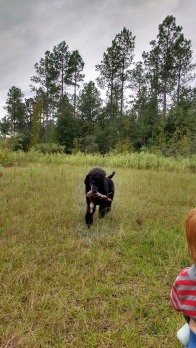Fall is here. There was frost on the ground this morning and I couldn’t stand being outside without a coat. Sorry for the slow blogging, we recently moved into county allowing for more dog space and some much needed people space. They dogs were upgraded to their own personal space outside with attached runs, and I finally have a space for ducks to be kept! So this morning, over ample coffee, I had some time to start delving back into my series on DIY Dog Training, this time tackling a important issue of building and designing a simple game plan for success and how to set up your dog to make the right choice.

One of the easiest way for at home owners to start changing or creating new behaviors is to sit down and think how the dog does the bad behavior. One of the easiest rules to follow is the dog can’t do x if its doing y. For instance, we have a dog who jumps at the door, instead of thinking what we can do to stop it, start thinking about what behavior conflicts with the first. Most people teach a sit. The dog can’t jump when it’s sitting. Another example, marking on furniture, quick fix keep the dog away from the furniture or belly band so the dog simply cannot do it. Seems easy right?
Right here it is good to note that we didn’t dive into WHY the dog is jumping at the door (or peeing on your furniture) only what would conflict with it. Good trainers are actively in search of the why the dog is doing something. Once you understand why the behavior is being presented you can train better.
Delving into the why of the two above examples. Does the dog get overly excited when the door is answered, is it because perhaps it needs more stimulation and exercise? Is it lacking self control on other thresholds or parts of it’s life? Are visitors rare? Why is the dog marking? Is it because it has an underlying infection? Was potty training never finished fully? Is there is new animal in the house? If you really want to modify your dogs behavior fully and permanently you need to understand the whys of the matter.
Now that I have given you a little bit on an intro lets talk about setting up the dog for success. How would we stop the jumper? Lets say the dog is simply a over stimulated young puppy. First off we develop a game plan where the dog could get enough physical and mental stimulation to help it retain some sanity when the exciting happens. We fist work on conditioning the dog to ‘sit’ or ‘place’ when the door rings (assuming these behaviors have been previously taught). Alone we practice ringing the door, the dog runs over in excitement but we counter with a opposing command, something that counters the dog jumping to greet. We reward the dog immediate for compliance and repeat, extending the time between the reward and command. Eventually fading out the command.
The potty training is a slightly different take. Once the dog is cleared of underlying possible medical issues, we start by deep cleaning the areas removing all possible scent residue. Then we make a clear plan how to keep the dog from repeating the behavior while we retrain. Kennel training is by far the most popular method for dealing with elimination issues, and if kennels aren’t your thing tethering the dog to your body will also help. What this does is keep the dog within your sight, helping prevent the usual sneak away to pee problem. But we need to investigate the why? Generally it is because something in the household has changed. Whether it be the addition of a new animal or human coming to live, an odd visitor, or simply some other change, all can cause a relapse of potty training. Figure out the cause of your dogs recent relapse. Figure out the triggers that cause the unwanted elimination and attempt to rectify them. Sometimes all it takes is a few weeks revisiting potty training and rewarding correct choices for a dog to extinguish the unwanted behavior.
By teaching the dog a conflicting behavior you generally can quickly modify the dogs behavior to something more acceptable. This well established technique is quite easy to learn and many trainers DIY or otherwise employ it for basic needs. In this segment I did not utilize any corrections in my training. Generally I attempt to teach people the modification by rewarding first off. I will be covering corrections at a later date because I do think it is an important topic to cover and one I utilize in my regular training. The next topic will cover basic correcting and how to go about it fairly.
Till then
~Happy Tails~